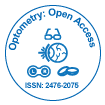Remote Eye Care: Expanding Access to Vision Health
Received: 03-May-2025 / Manuscript No. omoa-25-171440 / Editor assigned: 05-May-2025 / PreQC No. omoa-25-171440 / Reviewed: 17-May-2025 / QC No. omoa-25-171440 / Revised: 23-May-2025 / Manuscript No. omoa-25-171440 / Published Date: 29-May-2025 DOI: 10.4172/2476-2075.1000313
Introduction
Good vision is vital for overall well-being, yet millions of people worldwide struggle to access timely and affordable eye care services. Geographic barriers, cost constraints, and shortages of specialists often prevent individuals from receiving regular eye exams or treatment. Remote eye care, also known as teleophthalmology, is an emerging solution that uses digital technology to deliver vision care services at a distance. By combining telemedicine platforms, diagnostic tools, and digital imaging, remote eye care offers new opportunities to expand access, improve outcomes, and reduce the burden of preventable vision loss [1,2].
Discussion
Remote eye care involves the use of video consultations, mobile applications, and electronic data sharing to connect patients with optometrists and ophthalmologists. One of its most important applications is screening for eye diseases. Digital fundus cameras and other imaging devices can capture high-quality photographs of the retina, which are then transmitted securely to specialists for analysis [3-6]. This approach has proven particularly valuable in detecting diabetic retinopathy, glaucoma, and age-related macular degeneration—conditions that require early intervention to prevent blindness.
Teleophthalmology also improves access in underserved and rural areas, where eye specialists may be scarce. Patients can visit local clinics equipped with imaging devices, and their results can be reviewed remotely by experts. This not only reduces travel time and costs but also ensures earlier diagnosis and treatment. For elderly patients or those with mobility issues, remote consultations provide a convenient alternative to in-person visits [7,8].
Another significant advantage of remote eye care is its role in continuity of care. Patients with chronic eye conditions, such as glaucoma, often need frequent monitoring. Remote platforms allow for regular check-ins, ensuring that treatment plans are adjusted in real time. Mobile apps that track vision changes, send medication reminders, or provide educational resources empower patients to take an active role in their eye health.
Technology is driving further innovation in remote eye care. Artificial intelligence (AI) tools are increasingly being integrated to assist in interpreting retinal images, enabling faster and more accurate diagnoses. Wearable devices and smartphone-based vision tests are expanding opportunities for at-home monitoring, making eye care more patient-centered and accessible [9,10].
Conclusion
Remote eye care is transforming the delivery of vision services, breaking down barriers of distance and accessibility while providing timely screening, monitoring, and patient education. By leveraging telemedicine platforms, imaging technologies, and AI, it expands the reach of eye specialists and empowers patients to protect their vision. However, to maximize its potential, challenges such as access, training, and data security must be addressed. As healthcare continues to embrace digital innovation, remote eye care will play a pivotal role in reducing preventable vision loss and ensuring healthier communities worldwide.
References
- Cairns JE (1968)Trabeculectomy Preliminary report of a new method. Am J Ophthalmol 66: 673-679.
- Landers J, Martin K, Sarkies N, Bourne R, Watson P (2012) A twenty-year follow-up study of trabeculectomy: Risk factors and outcomes. Ophthalmology 119: 694-702.
- Lehmann OJ, Bunce C, Matheson MM, Maurino V, Khaw PT, et al. (2000) Risk factors for development of post-trabeculectomy endophthalmitis. Br J Ophthalmol 84: 1349-1353.
- Higashide T, Ohkubo S, Sugimoto Y, Kiuchi Y, Sugiyama K (2016) Persistent hypotony after trabeculectomy: Incidence and associated factors in the Collaborative Bleb-related Infection Incidence and Treatment Study. Jpn J Ophthalmol 60: 309-318.
- Gedde SJ, Herndon LW, Brandt JD, Budenz DL, Feuer WJ (2012) Tube Versus Trabeculectomy Study Group. Postoperative complications in the tube versus trabeculectomy (TVT) study during five years of follow-up. Am J Ophthalmol 153: 804-814.
- Nayak B, Gupta S, Kumar G, Dada T, Gupta V, et al. (2015) Socioeconomics of long-term glaucoma therapy in India. Indian J Ophthalmol 63: 20-24.
- Sihota R, Angmo D, Chandra A, Gupta V, Sharma A (2015) Evaluating the long-term efficacy of short-duration 0.1 mg/ml and 0.2 mg/ml MMC in primary trabeculectomy for primary adult glaucoma. Graefes Arch Clin Exp Ophthalmol 253: 1153-1159.
- Dada T, Kusumesh R, Bali SJ, Sharma S, Sobti A et al. (2013) Trabeculectomy with combined use of subconjunctival collagen implant and low-dose mitomycin C. J Glaucoma 22: 659-662.
- Vision A, Health E (2013) Prevalence and risk factors for myopia among school children in Aba, Nigeria. African Vis Eye Health 76: 1-5.
- Optometry C (2017) Prevalence and associated factors of myopia among high school students in Gondar town, northwest Ethiopia, 2016. Clin Optom 9: 11–18.
Citation: Shreya V (2025) Remote Eye Care: Expanding Access to Vision Health. Optom Open Access 10: 313. DOI: 10.4172/2476-2075.1000313
Copyright: © 2025 Shreya V. This is an open-access article distributed under the terms of the Creative Commons Attribution License, which permits unrestricted use, distribution, and reproduction in any medium, provided the original author and source are credited.
Select your language of interest to view the total content in your interested language
Share This Article
Recommended Journals
Open Access Journals
Article Tools
Article Usage
- Total views: 59
- [From(publication date): 0-0 - Nov 18, 2025]
- Breakdown by view type
- HTML page views: 39
- PDF downloads: 20
